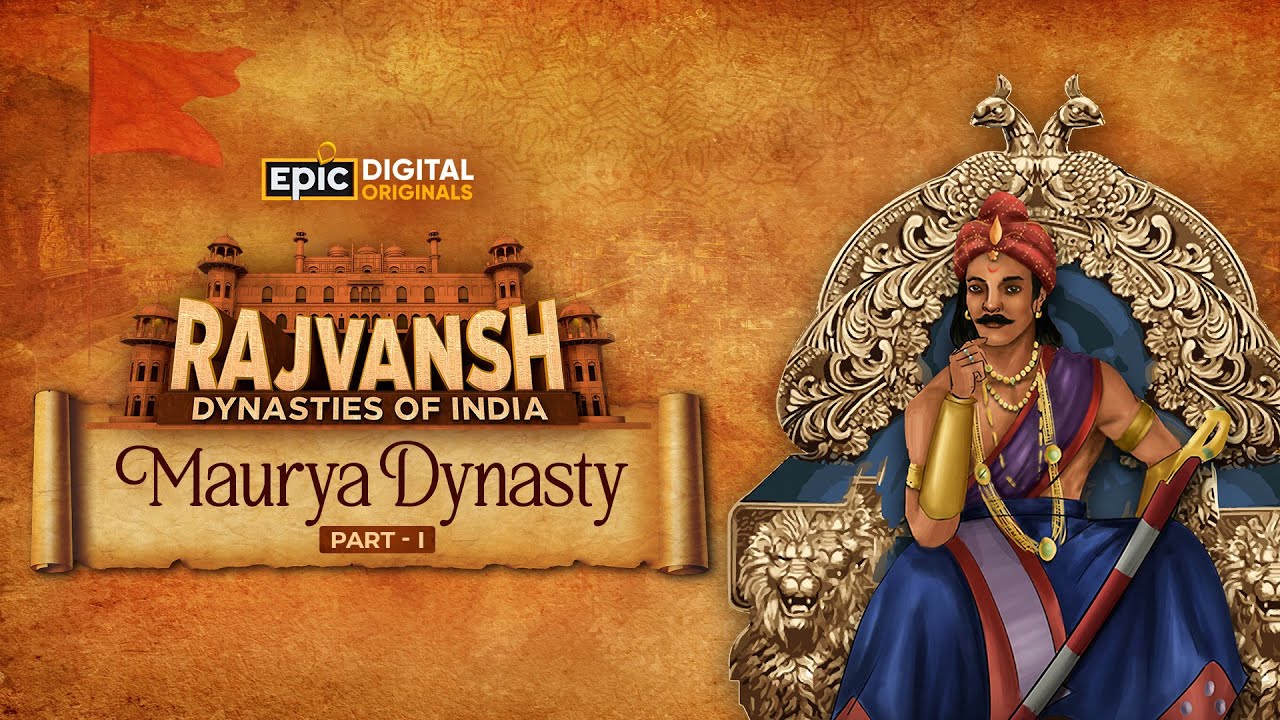Maurya Dynasty Part 2 | Rajvansh: Dynasties Of India | Full Episode | Ancient Indian History | Epic
Summary
TLDRThe Maurya Empire, founded by Chandragupta, expanded under Bindusar's reign, reaching its zenith under his son Ashoka. Initially a brutal ruler, known as Chandashoka, Ashoka's transformation began with the devastating Kalinga War, leading him to embrace Buddhism and promote cultural conquest. His reign saw the construction of stupas and pillars inscribed with religious doctrines. Despite Ashoka's peaceful death in 236 BC, the empire crumbled within 50 years, with the last king, Brihadrath, assassinated in 180 BC by Pushyamitra Shunga, marking the end of an era and the rise of new empires.
Takeaways
- 🏛️ Chandragupta founded the Maurya Empire, and Bindusar, his successor, expanded it significantly.
- 👑 Ashoka, Bindusar's son, inherited the empire and brought it to its zenith, leaving a lasting mark in history.
- 🌏 Under Bindusar's rule, the Mauryan Empire encompassed almost the entire Indian subcontinent.
- 🤝 Bindusar maintained diplomatic relations with Western rulers and hosted foreign ambassadors at his court.
- 👦 Ashoka was not the first choice for the throne, being the younger brother of the heir apparent, Sushim.
- 🛡️ Ashoka proved his worth by efficiently crushing a rebellion in Taxila, leading to his appointment as its governor.
- 🏰 Ashoka's rise to power involved the execution of his older brother Sushim and the elimination of other competitors.
- 👑 After ascending the throne, Ashoka initially ruled as a cruel, autocratic, and merciless king.
- 🌊 The Kalinga War was a turning point for Ashoka, leading him to abandon physical conquest in favor of cultural influence.
- 🕊️ Ashoka promoted Buddhism, building stupas, monasteries, and pillars with inscriptions of religious doctrines.
- ⏳ Ashoka's reign ended peacefully, and he donated all his possessions before his death in 236 BC.
- 📚 Ashoka's legacy was carried on by his sons, Mahendra and Kunal, and later by his grandson, Dashrath.
- 📉 Within 50 years after Ashoka's death, the Mauryan Empire collapsed, marking the end of an era.
- 🌅 The fall of the Maurya Empire paved the way for the rise of other empires such as the Shunga, Indo-Greek, and Satavahana Empires.
Q & A
Who laid the foundation of the Maurya Empire?
-Chandragupta laid the foundation of the Maurya Empire.
What significant action did Bindusar take to expand the Mauryan Empire?
-Bindusar expanded the empire by incorporating almost the entire subcontinent under its rule during his reign.
What was Ashoka's initial reputation before his transformation?
-Ashoka was initially known as a cruel, autocratic, and merciless king who derived sadistic pleasure from torturing his opponents.
How did Ashoka's reign change after the Kalinga War?
-After the Kalinga War, Ashoka abandoned the policy of physical occupation in favor of cultural conquest and promoted religious doctrines through inscriptions on stupas, monasteries, and pillars.
What was Ashoka's title before he became king?
-Ashoka was appointed the governor of Taxila after efficiently crushing a rebellion there.
What was the reason behind Ashoka's appointment as the governor of Taxila?
-Ashoka was sent to Taxila to suppress a rebellion that his elder brother Sushim failed to crush, and his success in this task led to his appointment as the governor.
Who was the intended heir to the throne before Ashoka ascended to power?
-Sushim, Ashoka's elder brother, was the heir apparent to the throne before Ashoka ascended to power.
What drastic actions did Ashoka take after his coronation?
-After his coronation, Ashoka executed his older brother Sushim and his 500 loyal officers, and subsequently had his other brothers killed to eliminate all competition.
What was Ashoka's policy towards conquered regions after the Kalinga War?
-Ashoka's policy towards conquered regions after the Kalinga War was to focus on cultural conquest rather than physical occupation.
What was the ultimate fate of the Maurya Empire?
-The Maurya Empire fell apart within 50 years after Ashoka's death, culminating in the assassination of the last Mauryan king, Brihadrath, by his commander Pushyamitra Shunga.
What empires emerged after the fall of the Maurya Empire?
-After the fall of the Maurya Empire, empires like the Shunga Empire, the Indo-Greek Empire, and the Satavahana Empire emerged.
Outlines

This section is available to paid users only. Please upgrade to access this part.
Upgrade NowMindmap

This section is available to paid users only. Please upgrade to access this part.
Upgrade NowKeywords

This section is available to paid users only. Please upgrade to access this part.
Upgrade NowHighlights

This section is available to paid users only. Please upgrade to access this part.
Upgrade NowTranscripts

This section is available to paid users only. Please upgrade to access this part.
Upgrade NowBrowse More Related Video

The Maurya Empire: The Mightiest Civilization India Has Ever Known

Maurya Dynasty Part 1 | Rajvansh: Dynasties Of India | Full Episode | Ancient Indian History | Epic

Why did The Maurya Empire Collapse? - The History of Largest Empire in Ancient India

Ancient History of India Series | Lecture 9: Rise of Mauryan Empire | GS History by Aadesh | UPSC

Pala Empire

Seluruh Sejarah Turki Utsmani dalam 10 Menit
5.0 / 5 (0 votes)